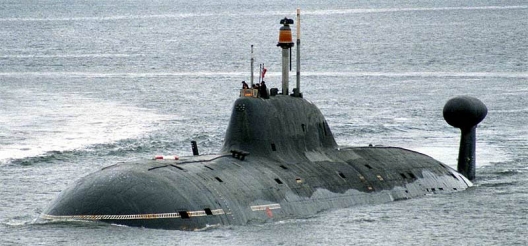 From Julian Borger, Guardian: A widening rift between Moscow and Washington over cruise missiles and increasingly daring patrols by nuclear-capable Russian submarines threatens to end an era of arms control and bring back a dangerous rivalry between the world’s two dominant nuclear arsenals. . . .
From Julian Borger, Guardian: A widening rift between Moscow and Washington over cruise missiles and increasingly daring patrols by nuclear-capable Russian submarines threatens to end an era of arms control and bring back a dangerous rivalry between the world’s two dominant nuclear arsenals. . . .
On Boxing Day, in one of the more visible signs of the unease, the US military launched the first of two experimental “blimps” over Washington. The system, known as JLENS, is designed to detect incoming cruise missiles. The North American Aerospace Command (Norad) did not specify the nature of the threat, but the deployment comes nine months after the Norad commander, General Charles Jacoby, admitted the Pentagon faced “some significant challenges” in countering cruise missiles, referring in particular to the threat of Russian attack submarines. . . .
The US military has also been rattled by the resurgence of the Russian submarine fleet. Moscow is building new generations of giant ballistic missile submarines, known as “boomers”, and attack submarines that are equal or superior to their US counterparts in performance and stealth. From a low point in 2002, when the Russian navy managed to send out no underwater patrols at all, it is steadily rebounding and reasserting its global reach.
There have been sporadic reports in the US press about Russian submarines reaching the American east coast, which have been denied by the US military. But last year Jacoby, the head of Norad and the US northern command at the time, admitted concerns about being able to counter new Russian investment in cruise missile technology and advanced submarines.
“They have just begun production of a new class of quiet nuclear submarines specifically designed to deliver cruise missiles,” Jacoby told Congress. . . .
[Former UK naval officer Peter Roberts:] “It’s something the Americans have been trying to brush off but there is increasing concern about the American ability to … track these subs. Their own anti-sub skills have declined, while we have all been focused on landlocked operations, in Afghanistan and so on.”
The Akula is being superseded by an even stealthier submarine, the Yasen. Both are multipurpose: hunter-killers designed to track and destroy enemy submarine and carrier battle groups. Both are also armed with land-attack cruise missiles, currently the Granat, capable of carrying nuclear warheads. . . .
Jeffrey Lewis, an arms control expert at the Monterey Institute of International Studies and founding publisher of ArmsControlWonk.com, believes the JLENS blimps are primarily a response to a Russian move to start rearming attack submarines with nuclear weapons.”For a long time, the Russians have been saying they would do this and now it looks like they have,” Lewis said. . . .
The Russian emphasis on cruise missiles is in line with Putin’s strategy of “de-escalation”, which involves countering Nato’s overwhelming conventional superiority with the threat of a limited nuclear strike that would inflict “tailored damage” on an adversary.
Lewis argues that Putin’s accentuation of Russia’s nuclear capabilities is aimed at giving him room for manoeuvre in Ukraine and possibly other neighbouring states.”The real reason he talks about how great they are is he saying: ‘I’m going to go ahead and invade Ukraine and you’re going to look the other way. As long as I don’t call it an invasion, you’re going to look at my nuclear weapons and say I don’t want to push this,'” he said.
Julian Borger is diplomatic editor of the Guardian.
From Jeffrey Lewis, Foreign Policy: The evidence is increasingly strong that not only is Moscow routinely sending submarines within an arm’s length of the United States coastline, but that these submarines are deployed with nuclear-armed SLCMs.
Here’s the problem: There is nothing to prohibit the Russians from putting as many nuclear-armed cruise missiles as they’d like aboard submarines and sailing them up and down the East Coast, because there are no arms control agreements that limit the number of Russian SLCMs. . . .
It’s not a coincidence that Russia seems to be deploying new SLCMs at the same time it is testing — in violation of the 1987 Intermediate-Range Nuclear Forces Treaty — a new long-range ground-launched cruise missile (GLCM). (Dumb, dumb, dumb.) Russia is also said to have a new air-launched cruise missile. (Only kind of dumb.) What’s more, the Russians are boasting of very large deployments to come: In July, Defense Minister Sergei Shoigu announced that Russia “will boost the number of cruise missiles fivefold in the next three years and by 30 times by 2020.” (If you want to try to create an order of battle, I’d suggest starting with Pavel Podvig’s Russian Strategic Nuclear Forces blog and, for naval issues, 7 Feet Beneath the Keel.)
It is hard to know how many cruise missiles a 30-fold increase would represent or whether such plans are even realistic — but you can guess I think they are pretty dumb. It does, however, seem we have a strategic problem on our hands. The Russians even market a cruise missile, the Club-K, that comes disguised as a shipping container.
Jeffrey Lewis is director of the East Asia Nonproliferation Program at the James Martin Center for Nonproliferation Studies.
Image: Russian Akula class submarine, June 3, 2008 (photo: Visergey)
